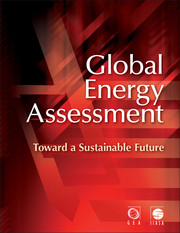Book contents
- Frontmatter
- Contents
- Section 1
- Section 2
- Section 3
- Cluster 1
- Cluster 2
- Cluster 3
- Chapter 17 Energy Pathways for Sustainable Development
- Chapter 18 Urban Energy Systems
- Chapter 19 Energy Access for Development
- Chapter 20 Land and Water: Linkages to Bioenergy
- Chapter 21 Lifestyles, Well-Being and Energy
- Cluster 4
- Section 4
- Index
- References
Chapter 19 - Energy Access for Development
Published online by Cambridge University Press: 05 September 2012
- Frontmatter
- Contents
- Section 1
- Section 2
- Section 3
- Cluster 1
- Cluster 2
- Cluster 3
- Chapter 17 Energy Pathways for Sustainable Development
- Chapter 18 Urban Energy Systems
- Chapter 19 Energy Access for Development
- Chapter 20 Land and Water: Linkages to Bioenergy
- Chapter 21 Lifestyles, Well-Being and Energy
- Cluster 4
- Section 4
- Index
- References
Summary
Executive Summary
Key Challenges
A quarter of humanity today lives without access to any electricity and almost one-half still depends on solid fuels such as unprocessed biomass, coal, or charcoal for its thermal needs. These people continue to suffer a multitude of impacts detrimental to their welfare. Most live in rural villages and urban slums in developing nations. Access to affordable modern energy carriers is a necessary, but insufficient step toward alleviating poverty and enabling the expansion of local economies.
Even among populations with physical access to electricity and modern fuels, a lack of affordability and reliable supplies limits the extent to which a transition to using these can occur. Those who can afford the improved energy carriers may still not be able to afford the upfront costs of connections or the conversion technology or equipment that makes that energy useful.
Beyond the obvious uses of energy for lighting, cooking, heating, and basic home appliances, uses for purposes that might bring economic development to an area are slow to emerge without institutional mechanisms in place that are conducive to fostering entrepreneurial activity and uses of energy for activities that can generate income. Without the expansion of energy uses to activities that generate income, the economic returns to energy providers are likely to remain unattractive in poor and dispersed rural markets.
Significant success has been achieved with small pilot projects to improve energy access in some rural areas and among poor communities in urban areas. But subsequently, less thought is focused on how to scale-up from these small pilot and demonstration projects to market development and meeting the needs of the larger population.
- Type
- Chapter
- Information
- Global Energy AssessmentToward a Sustainable Future, pp. 1401 - 1458Publisher: Cambridge University PressPrint publication year: 2012
References
- 26
- Cited by



